Join Us
Upcoming Events
Events listed below are drop-in events open to the public. Come with a dance partner or by yourself! For more information and to join us, just give us a call or text us at (860) 929-2365.
Saturdays @ 7:00PM-8:30PM – Social Dance Party, $20 admission
For more information on additional studio member lessons and classes, please call or text 860-929-2365.
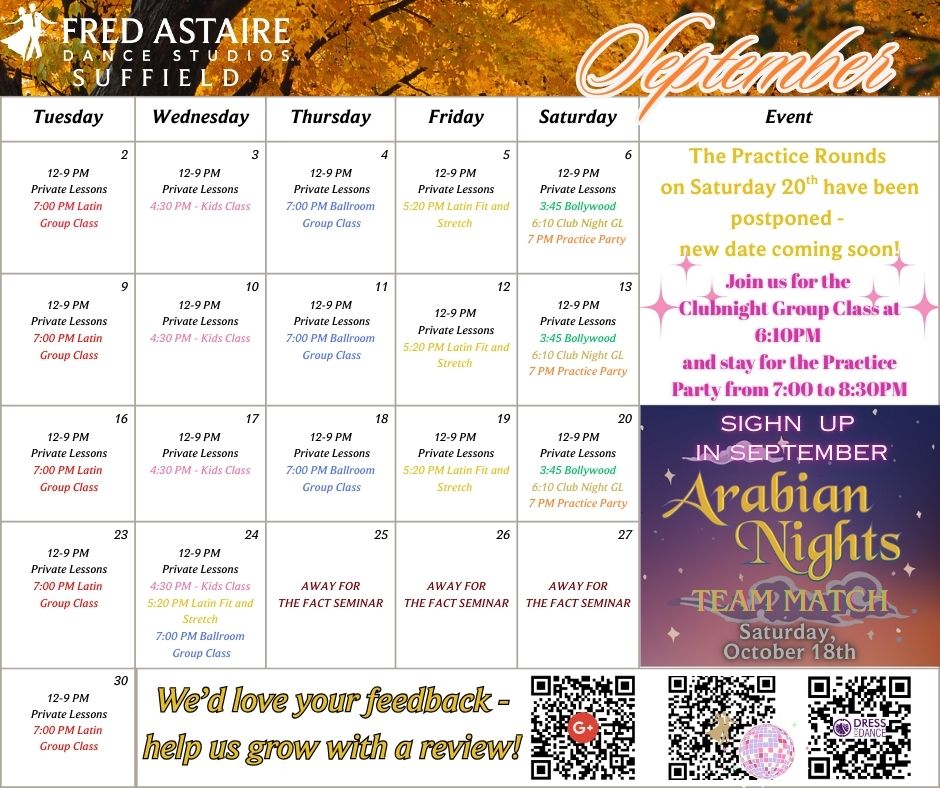
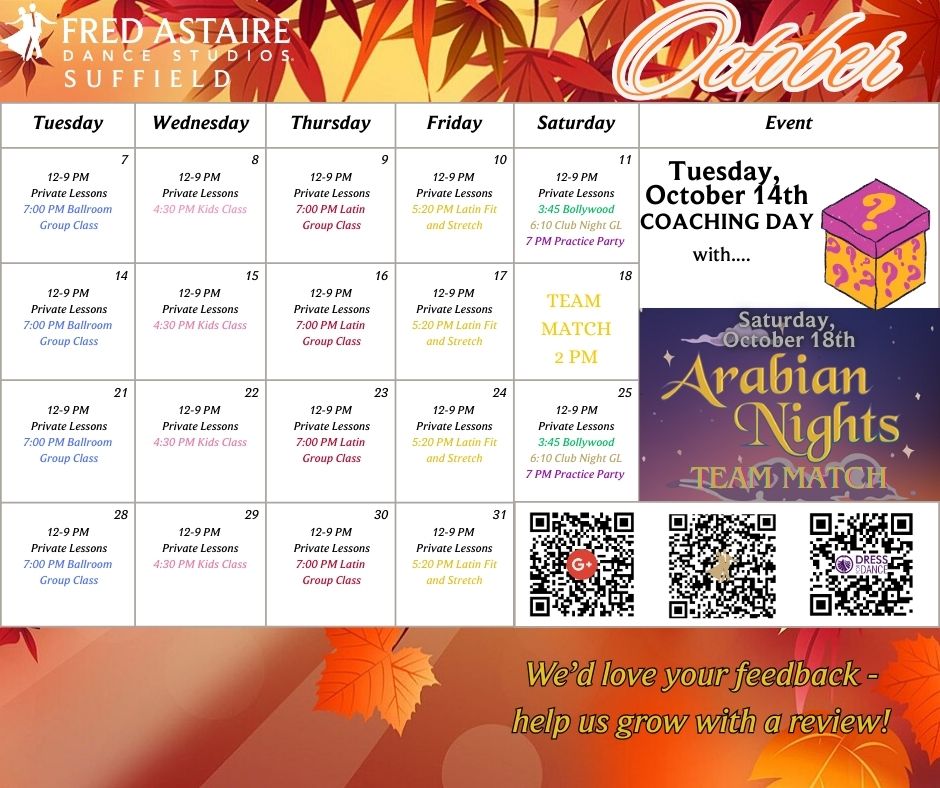

A ballroom practice party provides several key benefits for dancers of all levels. Here's an explanation of the value it offers:
1. Real-World Experience
Ballroom practice parties simulate the social dance environment, giving dancers the opportunity to apply techniques and routines in a relaxed, informal setting. This real-world experience helps dancers adapt to various floor conditions, partner dynamics, and music styles.
2. Enhanced Confidence
Practicing in a party setting allows dancers to gain confidence in their abilities. The informal atmosphere reduces performance pressure, encouraging dancers to experiment, make mistakes, and learn from them without fear of judgment.
3. Improved Social Skills
Ballroom dance is as much about social interaction as it is about technique. Practice parties provide a chance to interact with a range of partners, improving communication, lead-follow skills, and the ability to adapt to different dancing styles and levels.
4. Networking Opportunities
These events often attract dancers from different classes and levels, creating a vibrant community atmosphere. This networking can lead to new friendships, potential dance partners, and connections within the local dance scene.
5. Practice Beyond the Classroom
While lessons focus on specific skills and techniques, practice parties offer a broader context for applying what’s learned. Dancers can practice improvisation, transitions, and musicality in a less structured environment, which enhances their overall dancing ability.
6. Feedback and Learning
Experienced dancers and instructors are often present at practice parties, providing valuable feedback and tips. Observing and interacting with others also offers learning opportunities, allowing dancers to pick up new ideas and refine their skills.
7. Enjoyment and Motivation
Dancing in a lively, social setting can be highly motivating and enjoyable. The fun atmosphere of a practice party can reignite passion for dance, boost morale, and encourage regular participation and progress.
8. Stress Relief
Dancing is a great way to relieve stress and improve mood. The social and playful nature of a practice party helps dancers unwind and enjoy the process of dancing, which can be particularly beneficial after a week of intense training or work.
In summary, a ballroom practice party is a valuable component of dance training, offering practical experience, social interaction, and enjoyment. It complements formal lessons by providing a space to practice skills, build confidence, and connect with the dance community.
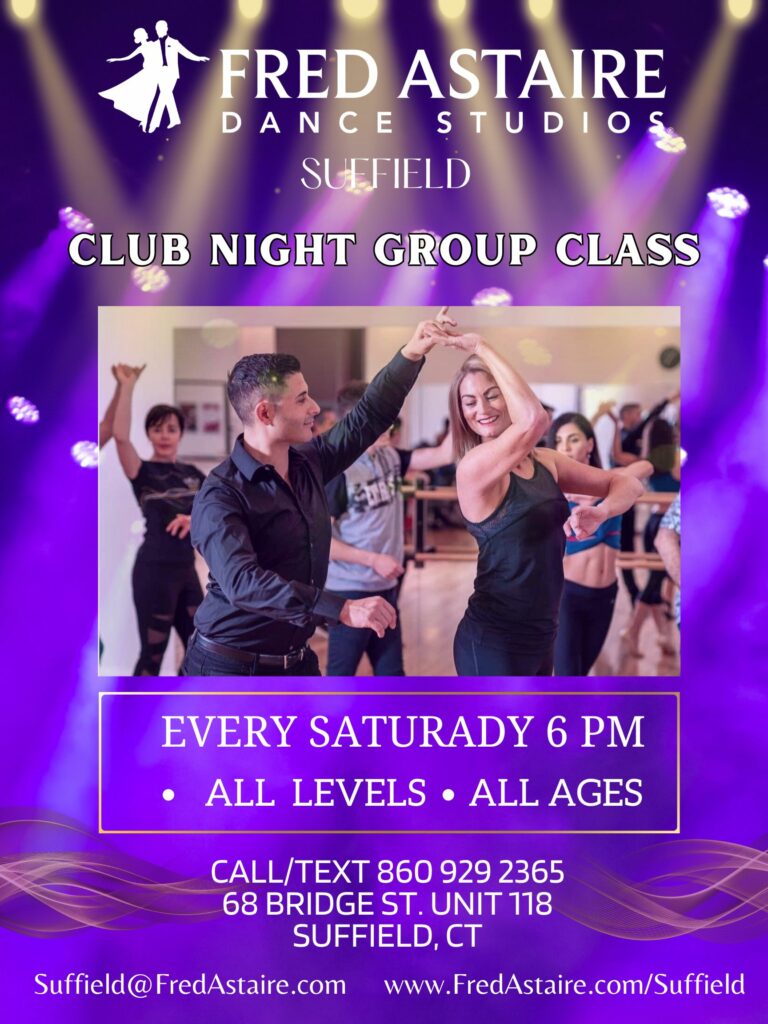
New * Club Night Dancing Group Class
Join us at the Suffield Fred Astaire
Dance Studio for our exciting new club Night Dancing Group Class! Perfect for dancers of all levels, Teaching Hustle, Salsa, Bachata, Merengue, West Coast Swing and Samba. This vibrant class is designed to enhance your club night dancing skills while fostering a fun and social atmosphere.
Participating in the Club Night
dancing group classes at the Suffield Fred Astaire Dance Studio offers a multitude of benefits that enhance both your dancing skills and overall well-being. Here’s a closer look at the key advantages of learning popular dance styles such as Hustle, Salsa, Bachata, Merengue, West Coast Swing, and Samba:
### 1. *Boosts Confidence*
Dancing in a group setting helps build self-esteem as you learn new moves and improve your technique. The supportive environment encourages you to step out of your comfort zone, empowering you to showcase your skills on the dance floor.
### 2. *Enhances Social Skills*
Dancing is inherently social, and our group classes provide the perfect opportunity to meet new people, make friends, and develop interpersonal skills. Engaging with a diverse group of fellow dancers fosters connections and camaraderie.
### 3. *Improves Physical Health*
Dancing is an excellent form of exercise that improves cardiovascular health, flexibility, and coordination. Styles like Salsa, Bachata, and Samba get your heart pumping and burn calories, promoting a healthier lifestyle.
### 4. *Explores Different Cultures*
Each dance style you learn offers a glimpse into its cultural origins and significance. For example, Salsa and Bachata are rooted in Latin dance traditions, while West Coast Swing thrives in the American dance scene. This cultural insight enriches your appreciation of dance as an art form.
### 5. *Develops Rhythm and Musicality*
Dancing enhances your ability to understand rhythm and music. With each new style, you'll learn to interpret music differently, improving your timing and synchronization with partners.
### 6. *Strengthens Body Awareness*
Learning various styles helps improve your body awareness, balance, and posture. Understanding how to move your body in sync with a partner cultivates a deeper connection and control in your movements.
### 7. *Encourages Lifelong Learning*
Dance is an ever-evolving art form, and engaging in lessons encourages a mindset of continuous growth. Each style offers new challenges and techniques, making dance a rewarding long-term hobby.
### 8. *Provides Stress Relief*
Dancing is a fantastic way to unwind and alleviate stress. Moving to music can be a joyful escape from daily life, and the camaraderie of group classes enhances the overall experience.
### 9. *Fosters Creativity*
Learning different dance styles encourages self-expression and creativity. As you become more comfortable with your movements, you'll feel inspired to improvise and personalize your dance style.
### 10. *Prepares for Social Events*
With the knowledge of various dance styles, you’ll be well-prepared for any social occasion, from weddings to parties. Being able to contribute to the dance floor in different genres ensures you can enjoy and celebrate these moments fully.
Join our Club Night dancing group
classes at the Suffield Fred Astaire Dance Studio and experience these benefits firsthand. Whether you’re a beginner looking to learn or an experienced dancer wishing to hone your skills, our classes are designed to elevate your dance journey!
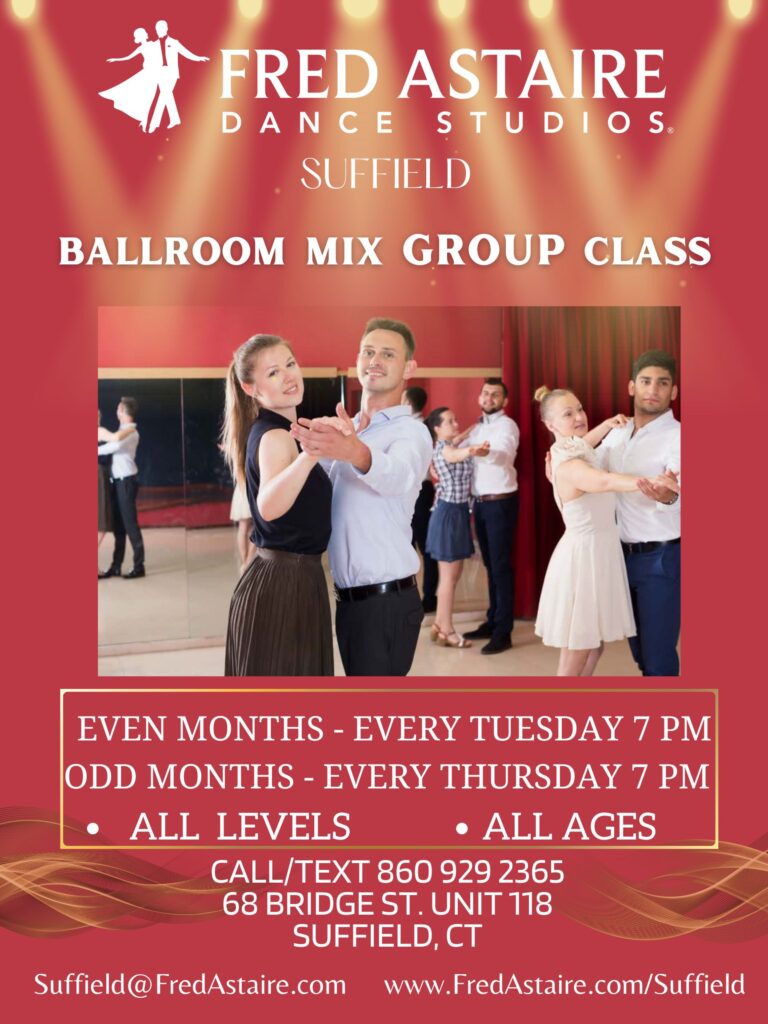
Ballroom group classes that focus on dances like the Waltz, Tango, Foxtrot, Viennese Waltz and Quick Step offer a range of benefits beyond just learning the steps.
Here’s a closer look at the specific value these classes can provide:
1. Physical Fitness
Cardiovascular Health: The Waltz, Tango, Foxtrot, Viennese Waltz and Quick Step involve continuous movement, which can improve cardiovascular fitness.
Strength and Flexibility: These dances require controlled movements and poses that enhance muscle strength and flexibility, particularly in the legs, core, and upper body.
2. Coordination and Balance
Graceful Movement: The waltz, with its flowing movements, and the precise steps of the foxtrot, help improve coordination and balance.
Posture and Alignment: Proper ballroom dancing technique emphasizes good posture and body alignment, which benefits overall balance and body control.
3. Social Interaction
Group Dynamics: Dancing in a group setting provides opportunities to meet new people, make friends, and develop a sense of community.
Partnering Skills: Learning to dance with a partner fosters communication and cooperation, which can enhance social skills and teamwork.
4. Confidence and Self-Esteem
Skill Mastery: Successfully learning and performing the waltz, tango, and foxtrot can boost self-confidence and personal satisfaction.
Performance Opportunities: Participating in showcases or social dance events provides a platform to demonstrate progress and gain positive reinforcement.
5. Stress Relief and Mental Well-being
Enjoyable Activity: Dancing can be a joyful escape from daily stress, providing relaxation and a mental break from routine tasks.
Mental Engagement: Learning and remembering dance steps requires focus and cognitive engagement, which can be mentally stimulating and fulfilling.
6. Cultural Appreciation
Historical Context: Each of these dances has a rich history and cultural significance. Understanding their origins and evolution provides insight into different traditions and eras.
Cultural Exposure: Dancing styles like the Waltz, Tango, Foxtrot, Viennese Waltz and Quick Step each have unique cultural roots, enhancing appreciation for diverse cultural expressions.
7. Skill Development
Rhythm and Timing: These dances help improve timing and rhythmic precision, crucial for maintaining the flow of the dance.
Technique and Grace: Each dance has distinct techniques that contribute to overall poise and gracefulness.
8. Creativity and Expression
Artistic Interpretation: The Waltz, Tango, Foxtrot, Viennese Waltz and Quick Step each offer opportunities for creative expression through movement, allowing dancers to convey emotion and personality.
Improvisation: While structured, these dances allow for personal interpretation and style, fostering individual creativity.
9. Communication Skills
Non-Verbal Communication: Dancing with a partner enhances non-verbal communication skills, as partners must interpret and respond to each other’s movements and cues.
Mutual Understanding: Effective partnering requires understanding and anticipating the partner’s actions, promoting empathy and coordination.
10. Fun and Enjoyment
Engaging Experience: The elegance of the Waltz, the passion of the Tango, and the smoothness of the foxtrot make these dances enjoyable and engaging for participants.
Social Events: Group classes often lead to social events or dance outings, providing additional opportunities for fun and enjoyment.
In summary, ballroom group classes focusing on the Waltz, Tango, Foxtrot, Viennese Waltz and Quick Step offer a holistic range of benefits, from physical fitness and skill development to social interaction and personal enjoyment. They combine the joy of dancing with valuable life skills and cultural enrichment.
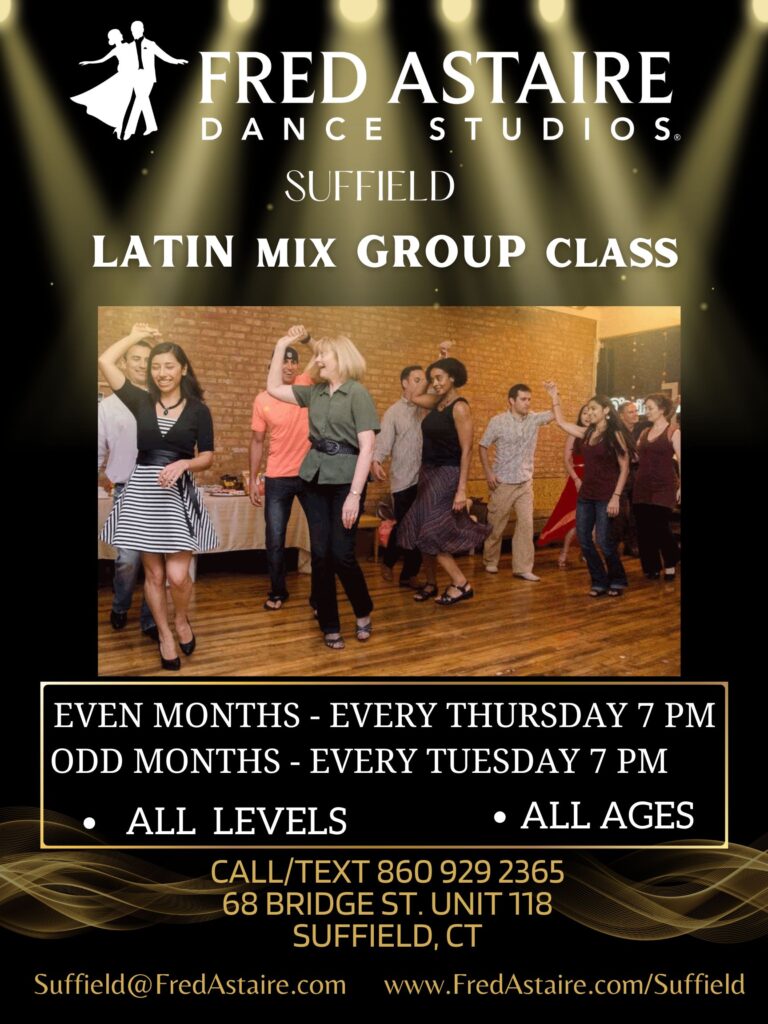
Latin ballroom group classes offer a range of benefits beyond just learning to dance. Here’s how they can be valuable:
Physical Fitness
Dancing Latin ballroom styles, like Salsa, Cha-Cha, and Rumba, provides an excellent workout. It improves cardiovascular health, enhances flexibility, and builds strength. The energetic movements and rhythms are a fun way to stay active.
Coordination and Balance:
Latin ballroom dancing requires precise footwork and body movement, which helps improve overall coordination and balance. This can benefit not only dancers but also everyday activities and overall physical agility.
Social Interaction
Group classes are a great way to meet new people and develop social skills. The collaborative
nature of dancing encourages interaction, teamwork, and communication, which can be especially valuable for building friendships and networking.
Confidence Boost
Mastering dance routines and performing in front of others can significantly boost self-esteem
and confidence. The process of learning and improving your skills on the dance floor helps build self-assurance.
Cultural Appreciation
Latin ballroom dances have rich cultural backgrounds. Learning these dances provides insight into the cultural traditions and histories of different Latin American countries, fostering a greater appreciation for global cultures.
Stress Relief
Dancing is a fun and engaging activity that can help reduce stress and improve mental well-being. The physical activity combined with the joy of dancing can be a great way to unwind and escape daily pressures.
Skill Development
Beyond dancing, group classes can enhance rhythm, timing, and musicality. They also promote discipline and perseverance
as students work to master various steps and routines.
Creativity and Expression
Latin ballroom dancing offers a creative outlet for self-expression. The music and movements allow dancers to express
themselves in unique ways, adding a personal touch to their performances.
In essence, Latin ballroom group classes provide a holistic set of benefits that enhance physical health, social connections, cultural awareness, and personal
growth.
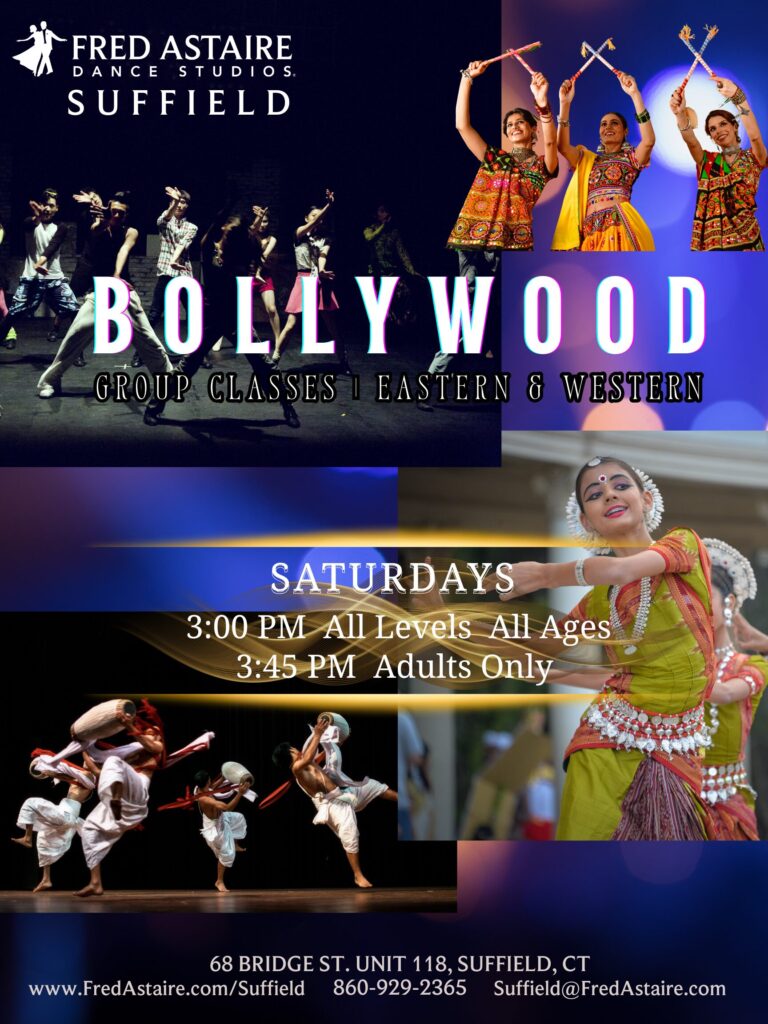
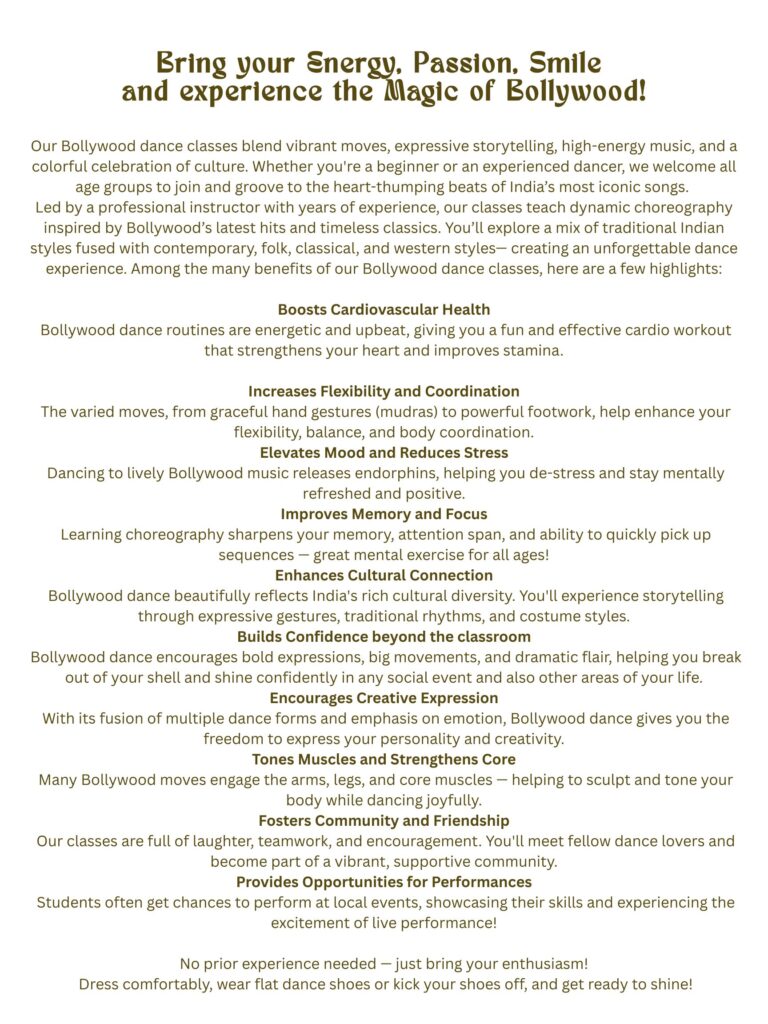
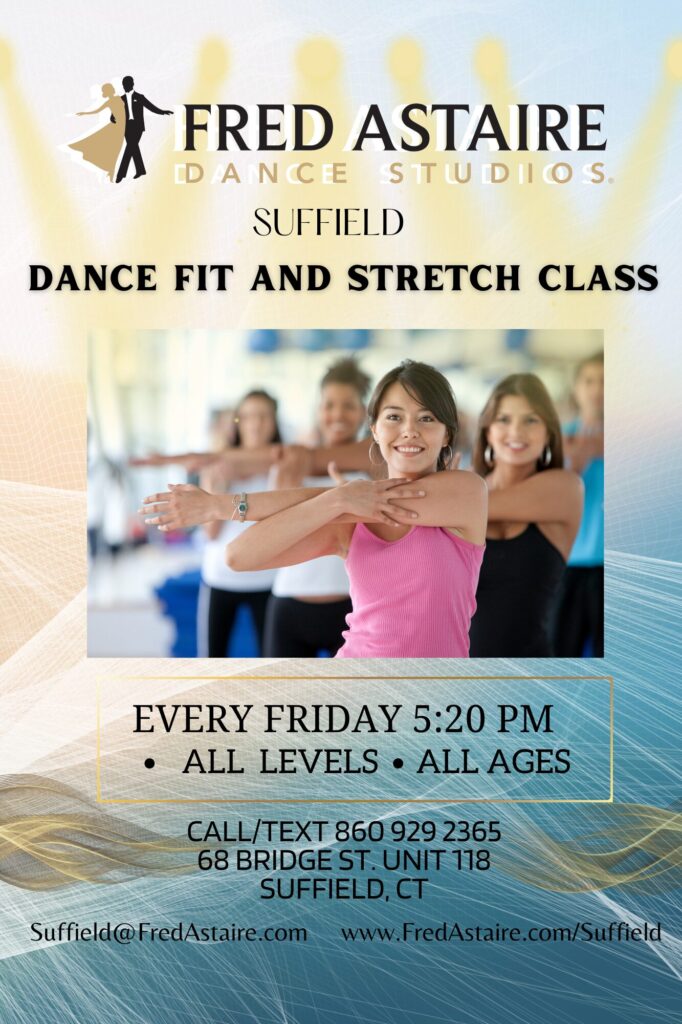
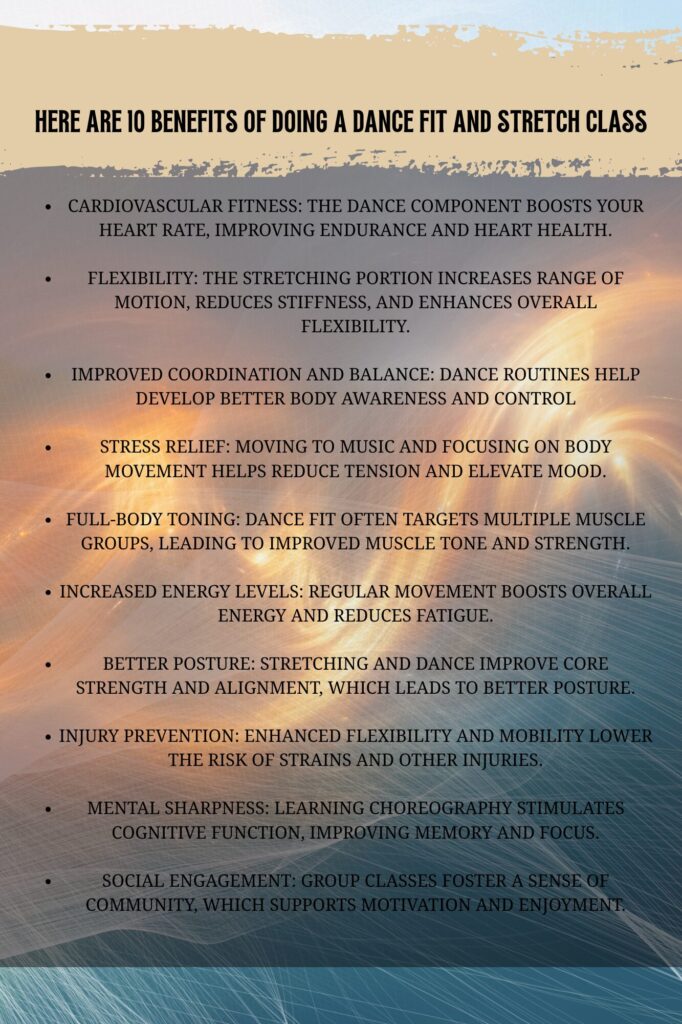

Ballroom dancing for children is a fantastic way to introduce them to the world of dance and its many benefits. Here’s an overview of what ballroom dancing for kids typically involves and why it’s such a valuable activity:
What Ballroom Dancing for Children Entails
1. Age-Appropriate Instruction: Classes for children are tailored to their age and skill level. Instructors often use games, fun exercises, and simplified routines to keep kids engaged and motivated.
2. Basic Steps and Techniques: Kids start with foundational steps and basic techniques in various ballroom styles such as the Waltz, Tango, Foxtrot, and Cha-Cha. This helps them build a strong base for more advanced moves.
3. Partner Work: Many ballroom dances require working with a partner, which introduces children to the concepts of leading, following, and coordination. Partner work is often done in a structured and supportive manner to ensure a positive experience.
4. Group Classes and Competitions: Children’s ballroom dance classes can be individual or group-based. Some programs offer opportunities to participate in local or regional dance competitions, providing a goal and a platform to showcase their skills.
5. Performance Opportunities: Kids may have the chance to perform in recitals or shows, which can be exciting and help build confidence.
Benefits of Ballroom Dancing for Children
1. Physical Development: Ballroom dancing helps improve coordination, balance, and flexibility. It also promotes overall physical fitness and helps develop muscle strength.
2. Social Skills: Dancing with partners and in groups teaches children how to communicate effectively, cooperate, and interact socially. They learn to work together, take turns, and respect others.
3. Confidence and Self-Esteem: Successfully learning new dance steps and performing in front of an audience can significantly boost a child’s self-confidence and self-esteem.
4. Discipline and Focus: The structured nature of dance lessons helps children develop discipline, concentration, and a strong work ethic as they practice and refine their skills.
5. Creativity and Expression: While ballroom dancing follows specific patterns, it also allows for creative expression and personal style within those frameworks, fostering artistic development.
6. Cultural Awareness: Exposure to various dance styles and traditions helps children appreciate different cultures and historical contexts, broadening their horizons.
7. Teamwork: Partner and group dances teach children how to work collaboratively, share responsibility, and understand the dynamics of teamwork.
8. Emotional Outlet: Dance provides a positive way for children to express their emotions, manage stress, and experience joy through movement.
Ballroom dancing for children can be a rewarding and enriching activity that provides a solid foundation for physical, social, and emotional growth. It combines learning with fun, making it an excellent choice for kids interested in exploring the art of dance.
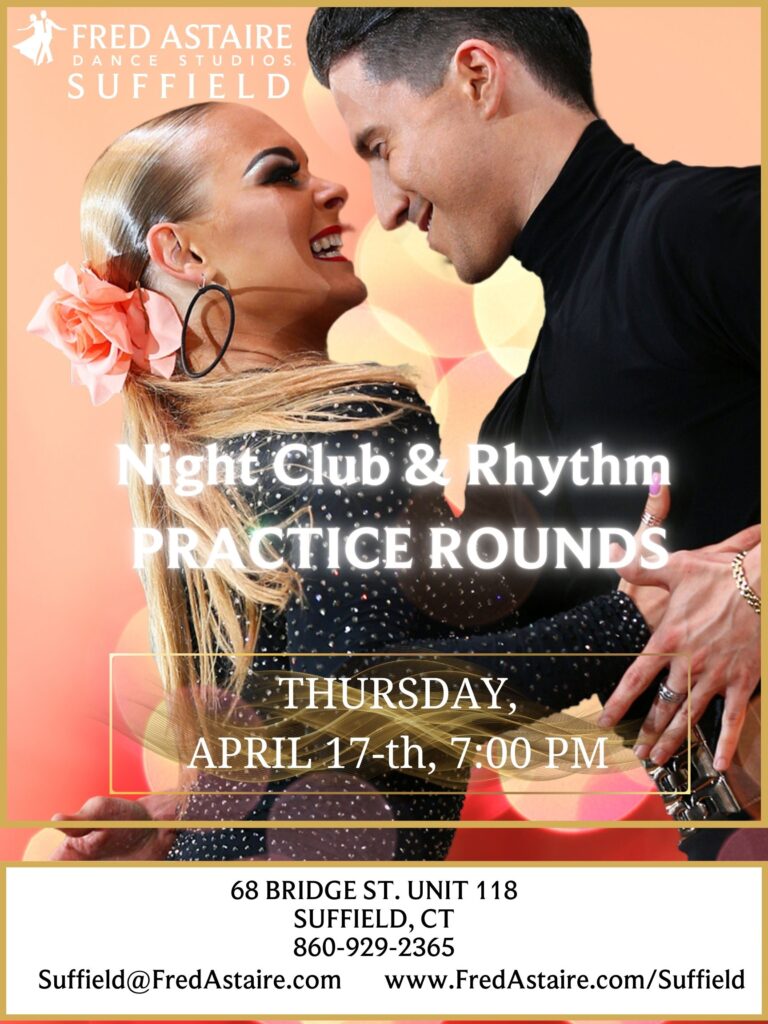
The Hidden Value of Rhythm/Latin Practice Rounds: Building Confidence Through Community
When we think about ballroom dancing, the glittering competitions and elegant performances often come to mind. But there's an unsung hero in the world of dance that’s just as important: practice rounds. These sessions, where dancers come together to practice their routines, are more than just an opportunity to polish your steps—they're a goldmine for building confidence and fostering community.
1. Boost Your Confidence
Practice rounds offer a supportive environment where you can test out new routines and techniques without the pressure of a formal competition. When you dance in front of your peers, you get to experience the thrill of performing while receiving constructive feedback. This helps you to refine your skills and build the confidence needed to shine in more high-stakes situations.
2. Foster a Sense of Community
One of the most rewarding aspects of practice rounds is the sense of camaraderie they build among dancers. As you share the floor with others, you create connections and friendships that go beyond the dance floor. This supportive network can be a source of motivation and encouragement, making your journey in ballroom dancing even more enjoyable.
3. Learn and Grow Together
In a practice round, you’re not just showcasing your own progress; you’re also observing and learning from others. Seeing different styles, techniques, and interpretations can inspire you and offer new perspectives on your own dancing. It’s a collaborative learning experience where everyone benefits from the shared knowledge and mutual support.
4. Embrace the Process
Practice rounds are a reminder that improvement is a journey, not just a destination. They allow you to embrace the process of learning and growing, helping you appreciate the small victories along the way. Each round is a step forward, helping you to better understand your strengths and areas for growth.
So, the next time you step onto the dance floor for a practice round, remember that it’s more than just a chance to refine your moves. It’s an opportunity to build confidence, connect with fellow dancers, and celebrate the joy of dancing together.
Keep dancing, keep growing, and most importantly, enjoy every moment of the journey!

